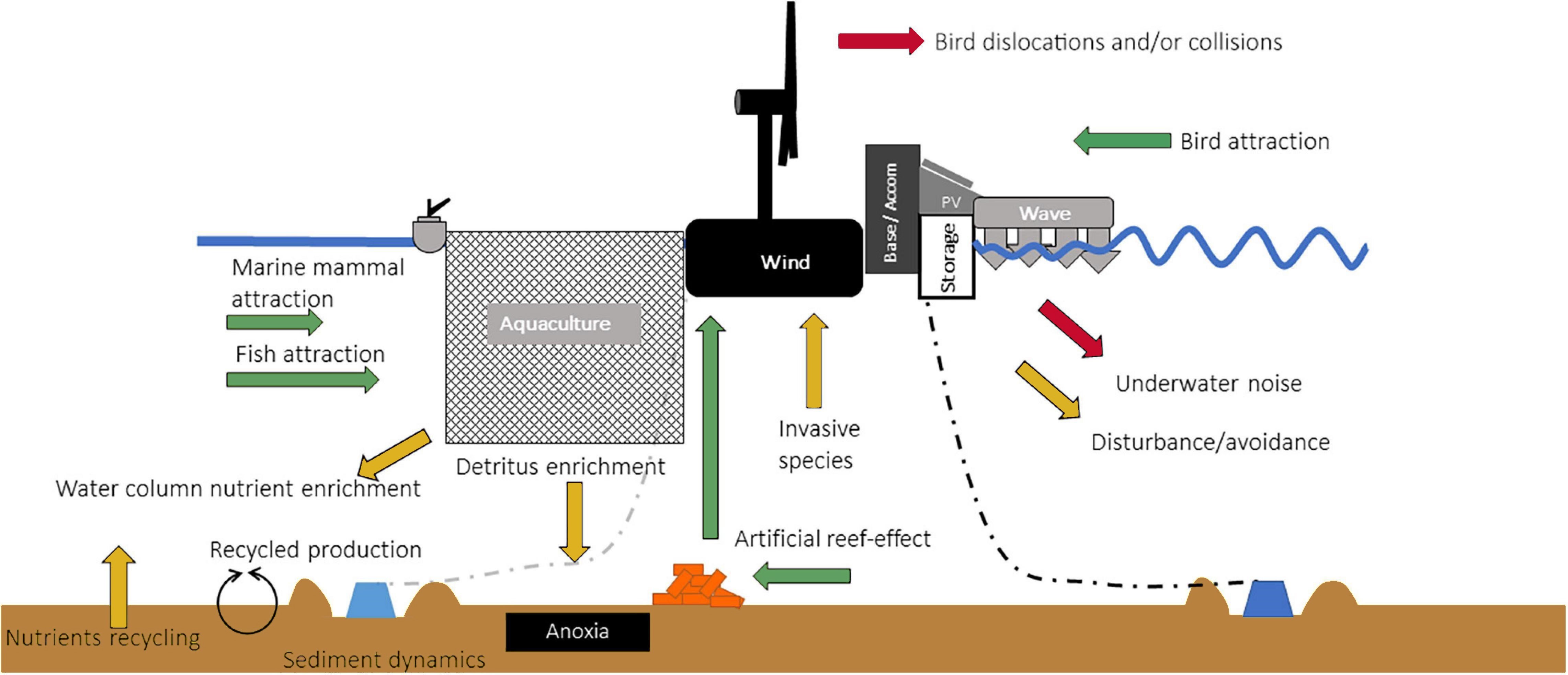As we move further offshore to meet the growing demand for marine renewable energy and aquaculture production, there is a growing need for structures that can combine and co-locate the production of these resources - so-called multi-purpose platforms (MPPs). However, understanding their immediate impacts on surrounding marine ecosystems is crucial before big-scale construction of such structures takes off globally.
The expansion of aquaculture and marine renewables and the emergence of multi-purpose platforms
Sustainable food production will require a constant expansion of the aquaculture industry: competition for space in near-shore coastal zones can, however, limit expansion. Instead, farms could be established further offshore where high-energy conditions also provide an opportunity to generate power locally using marine renewable energy (MRE) devices. How to optimise these two aspects? Natalia Serpetti and co-authors in their recent paper, published in Frontiers of Marine Science, propose the solution of co-locating aquaculture systems and MRE devices, such as offshore wind turbines (OWTs) - providing energy for farm operations as well as potential shelter. Serpetti is a member of the Working Group on Ecosystem Assessment of Western European Shelf Seas (WGEAWESS). Her paper aligns well with the main objectives of the expert group, which aims to use integrated ecosystem assessments (IEAs) to better inform marine management.
Serpetti et al. assessed single and cumulative impacts of the elements representing a hypothetical MPP off the west coast of Scotland that would farm salmon and co-locate OWTs next to the farm cages. The Ecopath with Ecosim and Ecospace (EwE) modelling approach used in the study evaluated specific ecosystem responses to top-down control pathways, changes in top predator distribution (e.g. harbour porpoise, gadoids, and seabirds) as well as bottom-up control pathways (e.g. increased benthic enrichment and consequent elevation of water nutrient levels).
Top-down, bottom-up pathway and cumulative impacts of multi-purpose platforms
The results showed weak responses of the food web for top-down changes (e.g. attraction for food by top predators to the MPP site vs. displacement of marine mammals and seabirds due to turbine noise), without significant increases or decreases in top predators' major prey species. Predator top-down controls were weakly cascading through the food web as their impacts were distributed across multiple preys, reflecting the complexity of their trophic interactions.
While top-down control pathways were only mildly affected, the results showed high sensitivity to increasing changes of bottom-up drivers that cascaded through the food web from detritus and primary producers to benthic and pelagic consumers, respectively. Bottom-up pathways have high energy transfer efficiency, where the energy mainly flows to a few predator groups, and can strongly affect food web structure and biodiversity. The primary productivity pathway also showed an amplification of the signal through the food web, with a large increase of relative biomass of small zooplankton; however, this amplification did not cascade to higher trophic levels (e.g. large zooplankton and herring).
This ecosystem-based modelling approach allowed the team to investigate the cumulative effects of the different MPP elements. In the cumulative impact scenario, the increasing productivity of the ecosystem, driven by bottom-up pathways, overruled the negative effects caused by the noise pressure and by predator attraction for most of the species impacted. Only harbour porpoises and seabirds did not show cumulative mitigating impacts.
“As with any model, validation is an important aspect to produce accurate predictions", says Serpetti. The limited availability of validation material for this study, and uncertainties around the assumptions made regarding noise pressure responses and species habitat preferences were the main limitations of the study. In the future, a sensitivity test should be carried out to assess the model performance.
The future of marine renewables and aquaculture in the face of current policies
Assessing the long-term environmental impacts in terms of eutrophication and noise is a priority for both the EU Water Framework Directive and the Marine Strategy Framework Directive. In the study, the cumulative impact scenario showed that the increasing productivity driven by the presence of farming can mitigate or even overrule negative effects caused by noise pressure and predator attraction. Assessing cumulative impacts will be important in the future for the Maritime Spatial Planning under the Integrated Maritime Policy. This work will also help in advancing some of the main goals of WGEAWESS, such as moving towards implementing IEAs as a tool for marine management and updating and improving ICES Ecosystem Overviews.
“Aquaculture and marine renewable energy are two expanding sectors of the Blue Economy in Europe", concludes Natalia. “Moving toward renewables as a greener and more sustainable option in the face of climate change and due to the necessity of aquaculture production, we propose the use of MPPs to maximise the benefits of these expansions and minimise their impacts".

Potential environmental interactions of a hypothetical MPP structure. Green arrows indicate potential for attraction of species (fish, mammals, birds, epifauna); yellow arrows indicate potential wider ecosystem impacts (substrate availability for invasive species, detritus enrichment, noise); red arrows indicate potential adverse/lethal impacts (dislocations and collisions of birds and bats with wind turbines; underwater noise). Image: Ben Wilson and Steven Benjamins, modified by Natalia Serpetti. Click to enlarge.
Working Group on Ecosystem Assessment of Western European Shelf Seas
Serpetti, Scottish Association for Marine Science fellow and WGEAWESS member, used the EwE modelling approach in the current study, a food-web model that has often and successfully been used to assess the direct and indirect effects of anthropogenic pressures on ecosystem dynamics and to evaluate how such pressures cascade through the food web.
The Working Group on Ecosystem Assessment of Western European Shelf Seas (WGEAWESS) focuses on using integrated ecosystem assessments (IEAs) to inform the ecosystem approach to marine management of the Atlantic European continental shelf. The group explores the possibilities of models in ecosystem-based marine management, selecting case studies within WGEAWESS ecoregions to identify opportunities to support marine spatial planning, and to inform the Ecosystem Overviews. Ecosystem models have proven to be useful for modeling natural and anthropogenic variability and, in some cases, have been also used to inform management measures.

